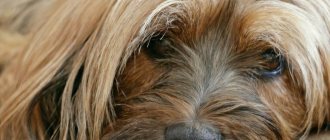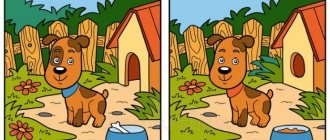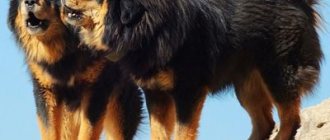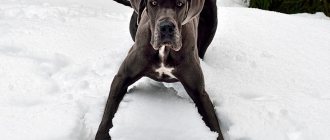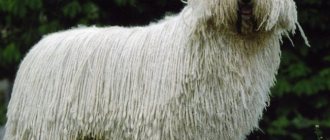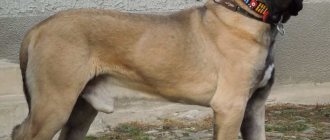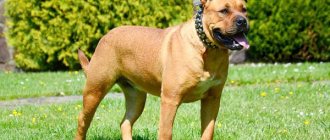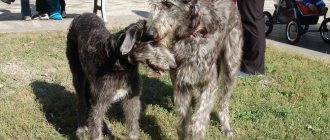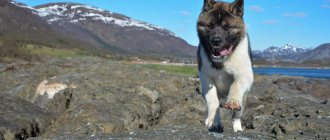Mastiffs are a large group of breeds that include Tibetan, English, French, German, Pyrenean, Major, American, Brazilian, Pakistani and other varieties of these dogs.
Spanish Mastiffs are large and strong dogs, the stern expression of their muzzle can terrify anyone who is not familiar with this breed.
In fact, it is simply impossible to say that they are ferocious. Once you get to know them better, their good-natured attitude and affectionate nature immediately become noticeable.
However, there are several features that everyone who is thinking about purchasing this dog should know in advance.
In the article you will find a description of this breed, its characteristics and features.
History of the breed
There are many versions of the origin of Spanish mastiffs, but only 2 of them are the most reliable. Some scientists say that the ancestors of these dogs were brought to Europe by Phoenician merchants, others are inclined to believe that they owe their appearance here to Asian nomads.
Mastiffs are similar to Turkish, Caucasian, Balkan and Tibetan shepherd dogs, so it is impossible to reliably determine which of them is the ancestor of the Spanish mastiffs, but it is likely that all these breeds have common roots.
It is known that Spanish mastiffs existed as a separate breed back in the 15th century. and were engaged in grazing cattle in the Pyrenees.
NOTE!
This dog breed became widely known only at the beginning of the 20th century, and the first standard was determined at the end of the Second World War. Having gained international recognition, Spanish Mastiffs became even more popular, but were still inferior to German Shepherds and Rottweilers.
Spanish mastiffs were brought to Russia in the mid-90s from a Czech nursery.
Interesting Facts:
- Until 1929, this breed was called a little differently - “mountain Spanish mastiff”.
- Spanish shepherds, who still use these dogs as workers, say that they are invincible - they never succumb to wolves and always win in a fight.
- These are dogs of late maturation: males reach maturity by three years, females by two.
Description of the breed
The original purpose of the “Spaniards” was herding work, but when the urgent need for it disappeared, the mastiffs retrained as guards. They take this activity with great responsibility - as well as everything that the owner instructs them to do. Often, just the impressive appearance and guttural bark of these dogs is enough to discourage intruders from any desire to enter someone else’s territory.
Exterior
The standard classifies the Spanish Mastiff not by its purpose, but by its exterior type, and therefore classifies the breed in the second section (“Molossians and Mastiffs”) of the second group.
The dimensions of the Spanish Mastiff are comparable to the size of an average pony.
Table: Spanish Mastiff exterior according to FCI standard No. 91 (2002)
| Main articles | Description |
| Dimensions |
|
| Addition |
|
| Head |
|
| Limbs |
|
| Tail |
|
| Wool |
|
| Colors |
|
The Spanish Mastiff moves easily and harmoniously
The Spanish Mastiff moves easily, even gracefully, which is unexpected given its enormous mass. The freedom and elegance of movement for such a powerful dog is ensured by the ideal balance of his body: strong hind legs give a strong push, and the front ones give a large reach. Ambling is unacceptable for this mastiff.
Photo gallery: some colors of the Spanish Mastiff
This light color is considered the original color for the breed.
Dark color variations have appeared among the Spaniards only recently
Shades of noble fawn color are magnificent on the fur of a giant dog
The rich and positive fawn coloring turned out to suit the Molossians
Many owners like the brindle color of the Spanish Mastiff.
Character and behavior
The senior mastiff has a kind and friendly character; he will willingly communicate even with a stranger whom the owner has brought with him - but only as long as the owner is nearby and the guest does not violate the rules of decency. The dog will stop any encroachments on the owner’s interests quickly and decisively.
He adores children and enjoys working as a nanny, controlling the movements of his powerful body with touching caution so as not to push the child. Surprisingly, he succeeds!
These menacing dogs make great nannies.
The Spaniards generally show increased tolerance towards everyone who is smaller and weaker: they will never offend a small breed dog, even the most scandalous one, or other domestic animals. But they may well begin to sort things out with their own kind - over food, for example, or for love.
But such skirmishes do not end in death - they are more of a show than a duel, especially among males: huge scary dogs with a terrible roar rear up, roll on the ground, intertwining their bodies with the enemy... But after a few minutes the rivals will peacefully sip water from the same bowl , and then they will fall asleep next to each other on the bedding.
A big and strong mastiff does not hurt small ones
Dogs of this breed are balanced, calm and self-confident - they are really aware of their strength and know how to use it correctly. In the body of a formidable dog lives a gentle and sensitive soul, and for this alone, when choosing a friend, you should think about the Spanish Mastiff first of all.
Disqualities and disadvantages
The standard clearly defines the defects of the breed for which its representative can be removed not only from the exhibition, but also from breeding programs. The list of disqualifications for a Spaniard looks like this - although some of its points may seem insignificant to an uninitiated person:
- aggressiveness or cowardice;
- depigmented nose or mucous membranes;
- bifurcated nose;
- pronounced undershot or overshot.
The breed standard places strict requirements on the appearance, behavior and health of representatives of the breed.
Description and standard
Spanish Mastiffs are large, strong, proportionally built dogs. When you see representatives of this breed, you cannot help but notice their grace and grandeur. The sense of dignity of these dogs can be read in their entire appearance - from their posture and gaze to their demeanor in public and their unfettered, swift, free movements.
Characteristics of the breed standard:
- the head is large, but harmonious relative to the body;
- the transition from the forehead to the expressive, powerful muzzle is weakly expressed;
- the skin is thick, does not fit tightly;
- rectangular body;
- the chest is powerful and deep;
- The loin is wide and powerful, the croup is muscular;
- the shoulder and shoulder blades are wide;
- the stomach does not sag slightly due to the large volume of skin;
- limbs are strong, straight, set wide and parallel to each other, the hind limbs are more powerful;
- paws are large, oval;
- powerful jaws, scissor bite;
- the nose is large and black;
- eyes oval, brown;
- there are wrinkles on both sides of the eyes, giving the dog a serious appearance;
- The ears are triangular, hanging, set wide and low.
The coat is of medium length, thick, close to the body, slightly wavy, the undercoat is thick and dense.
Appearance
The Spanish Mastiff is a large dog, well-built, muscular, powerful, with a large head and medium-length hair. The body has an elongated shape, but harmony and lightness should be traced in movements and proportions. gender identity is guessed very well. The height at the withers for males is from 77 cm, for females - from 72 cm. Weight is not defined by the standard, with a minimum size of 70-80 kg. The head is strong, large, shaped like a truncated pyramid with a wide base. The skull is strong, with a pronounced occipital protuberance and a convex profile. The large upper lip covers the lower lip, and the jowls are well developed. The teeth are strong and white. The eyes are small in relation to the skull, almond-shaped, preferably dark in color. The eyelids are pigmented and thick. A slightly drooping lower eyelid allows you to see the mucous membrane. The ears are drooping, triangular in shape, flat, medium in size, and can be cropped.
The sky is black. The neck is strong, flexible, with a well-developed dewlap. The body is rectangular in shape, powerful and strong, indicating great strength, but at the same time mobile. The back is flexible and powerful. The ribs are rounded. The loin is wide and long. The croup is strong, its height is equal to the height at the withers. The chest is deep, wide, very powerful. The tail is thick, reaching to the hocks, and the terminal quarter is often curved. The front legs are straight, parallel, strong, with powerful pasterns. The hindquarters are straight when viewed from behind, with long and strong bones. The feet are round and the toes are close together. Single or double dewclaws are desirable on the front and hind legs, but their absence is acceptable. The skin is thick, elastic, forms many folds, and has good dewlap in the neck and abdomen. The coat is long, thick, with a well-developed undercoat, shorter on the legs, longer on the tail. The color can be different, the most valuable uniform ones are red of any shade, black, as well as any variants of these colors - motley and brindle.
The official breed standard was approved in 1981, and is determined by the following characteristics:
- 1. expectancy : 10–12 years.
- 2. Height: 72–78 cm.
- 3. Weight: 70-120 kg.
- 4. Color: red, fawn, brindle, black and white, black and red.
- 5. Coat: hard, medium length, thick undercoat.
- 6. Head: large, square-shaped. The eyes are brown, the ears are hanging, triangular in shape.
- 7. Limbs are long, well developed.
- 8. The tail is thick.
Character traits
By the appearance of these dogs one can judge their endurance and performance.
Despite their impressive size, which can frighten people unfamiliar with this breed, Spanish mastiffs have a calm, even and balanced character, while they are not devoid of self-esteem and feel superior to others.
The Spaniards are not aggressive and will never attack without a good reason. Outwardly, they seem melancholy and indifferent to everything, but this instantly changes as soon as the dog sees a threat.
Representatives of this breed behave calmly, affectionately and gently with the owner and other family members. They become reliable and devoted friends and faithful helpers. Spanish Mastiffs need their owner's attention, love and care.
These dogs get along well with children, become their nannies and protect them from dangers. They tolerate children's pranks and take part in games with pleasure.
The Spaniards do not have problems with other animals either - they are friendly towards other dogs, and for them cats, livestock and small pets are part of the owner’s property, which they consider it their duty to preserve and protect.
Expert opinion
Kozhevin Semyon Kirillovich
Expert dog handler.
Spanish mastiffs are absolutely not characterized by causeless aggression, anger and disobedience. These are good-natured and calm dogs, attached to their family and the territory entrusted to them - they do not try to escape by digging or jumping over a fence. However, in order for a dog to show its best qualities, it is necessary to make some efforts and seriously engage in its upbringing - an untrained and unsocialized Spanish Mastiff can be a threat, since not everyone can cope with it.
Origin story
The ancestors of the modern mastiff lived for centuries in the Pyrenees, Extremadura, Andalusia, on the Catalan coast and other historical regions of Spain. The economy in this area was based on sheep farming, which flourished largely thanks to mastiff dogs (that’s what the Spaniards called the guards of the herd, without any prefixes or additional words). Mastiffs were born and lived together with sheep and were an integral part of the herd, so when the owner of the flock changed, the dog was given away along with the cattle. Different territories developed their own type of dog, which was suitable for specific local conditions and climate.
The breed developed thanks to sheep farming. In his chronicle of shepherd life, Emanuel Delrio noted that there were usually five mastiffs per thousand sheep. If we compare these data with the number of livestock in the 18th century, we get a figure of about 20,000 individuals. Cattle breeders strictly selected dogs for working qualities, but also took into account external characteristics, such as the depth of the body, head size, the presence of folds and jowls.
Despite their large numbers and widespread distribution, mastiffs did not receive much attention until the 20th century.
The first officially registered mastiff was a piebald male named Machako. In 1906 he was recorded in the Spanish stud book. He could not be called a standard of beauty, but no other mastiffs were brought to the exhibition in Madrid. Under the pressure of urbanization, wolves began to leave the vicinity of villages, and with them small fur-bearing animals, which were the main food for large dogs. Farmers began to switch to more comfortable dogs, small and agile. The breed began to degenerate and was preserved only thanks to individual sheep breeders who continued to breed mastiffs, and, of course, to breeders who remembered their national heritage and laid the foundation for factory breeding of the Spanish Mastiff.
The first description of the Spanish Mastiff was written in 1946 for the FCI by breeder Luis Del Portillo, in which the dogs were described as large dogs with short hair. In the late 50s, Luis began searching for large mastiffs, which he collected from pastures in the province of Leon. In the early 60s, a significant contribution to the breed was made by the breeder Amodel Alejandro, who from the 70s to the 80s was involved in breeding and popularizing large dogs. It was his dogs that laid the foundation for several lines that are still known to this day: Manalo Martineda, Ermiño Tascona, Sacaries Pieto and El Pinotara.
At the end of the 70s, a new standard was created that was more consistent with the modern appearance of Spanish mastiffs. In 1981, the breed was officially recognized by the Fédération Cynologique Internationale and a Spanish Mastiff breeding program was developed under the leadership of Carlos Solas. The first Spanish mastiff appeared in Russia in 1995, and in 1996, 10 more dogs were imported from the Czech Republic and Spain, which became the founders of Russian lines.
The number of nurseries began to increase, of which today there are already more than 10.
Video about the Spanish Mastiff dog breed:
Advantages and disadvantages
Loyalty and affectionate disposition are not all the advantages of Spanish mastiffs.
The advantages of this breed include:
- courage;
- endurance and performance;
- intelligence and learning ability;
- patient and unobtrusive disposition;
- ability to get along with other animals and children.
Minuses:
- stubbornness;
- need for constant attention;
- the need for physical activity;
- heavy shedding;
- not suitable for apartment living;
- late emotional maturation.
Puppies receive temperament at birth, but character development takes about 4 years. It is believed that Spanish Mastiffs are dogs that take a long time to mature, so most of the shortcomings of these dogs are associated with improper upbringing.
Education and training
Mastiffs are very stubborn and willful dogs that are difficult to train with standard training.
They are used to working and making decisions independently, and therefore do not strive to unquestioningly follow the owner’s instructions. For this reason, it is categorically not recommended to get a mastiff for people who have not previously kept dogs of large breeds and, even more so, for those who are planning to get a dog for the first time.
Training Spanish Mastiffs involves education and regular interaction with the dog; they do not respond well to drilling, which is widely accepted for most breeds. Proper socialization is of great importance. With good upbringing, the Spaniard grows into an independent guard dog that can be listened to. In everyday life, the mastiff is obedient and friendly; in work he prefers to follow instinct and personal convictions. It should be remembered that Spanish Mastiffs are formed physically and psychologically before the age of three.
Photos of colors
For Spanish Mastiffs, almost any coat color is acceptable. Most often, representatives of the breed are found with yellow-cream, black, brindle, fawn and white-black coat.
Dossier
Adult dog height: 77 cm. Weight: 90 kg. Characteristic color: plain of any shade. Coat length: medium. Life expectancy: up to 11 years. Advantages of the breed: good guard, smart, loyal, does not require any special care. Difficulties of the breed: suitable for living in a private home, requires education and training. Average price of a Spanish Mastiff : $500-4000. Classification: large, security guard.
Is it suitable for living in an apartment or outdoors?
Spanish Mastiffs cannot be kept in an apartment; they need space.
Dense coat and thick undercoat allow these dogs to withstand both heat and cold without problems, so the most suitable option is a heated indoor enclosure and regular walks outside the site.
IMPORTANT!
These dogs should not be kept on a chain. They need constant contact with a person and the opportunity to splash out energy.
Character
Such pets are distinguished by their flexibility and reliability. It is because of their nature that they are used to protect pastures. Thanks to their kindness, they are able to protect weaker creatures from predators. But, despite everything, such a dog is calm, never attacks without warning, which has created a stereotype about the Spanish Mastiff pet as a good-natured mattress. Before attacking, it will warn the enemy by barking or growling.
One of the traits for which these animals are most valued is loyalty. They will faithfully serve their owner, especially if they feel affection. Another characteristic of the Spanish Mastiff is its love of freedom. They are uncomfortable in apartments; there is nowhere to move, even if the area is huge. A private house with a large yard is much better suited.
The flexible nature makes it easy to raise a pet. He will get along with other pets, including cats. With proper upbringing, you will find a friend, as well as a reliable nanny for your child. The species is distinguished by its kindness towards the weaker. Families who sometimes entrust their children to them say that the pets treat the child very carefully and do not get angry at the little pranks of the little ones.
Their docile nature makes it easy to raise a pet. Mastiffs are highly trainable, so they are easy to teach a variety of commands. But you shouldn’t demand precise execution from them after the start of training. To help him learn faster, praise him, because everyone loves encouragement.
How to properly care?
Caring for representatives of this breed is not difficult, the main thing is to accustom your pet to hygiene procedures from childhood and carry them out regularly.
Wool and bathing
You need to brush your dog with a metal brush 2-3 times a week, and daily during the shedding period.
After each walk, you need to wash your pet’s paws and belly, and give him a full bath no more than once a quarter, using a special shampoo that matches his coat type.
Claws
With regular and long walks, the Spanish Mastiff's claws grind down to the required length on their own. If this does not happen, they need to be trimmed with a nail clipper about 1-2 times a month, and the sharp edge should be filed with a nail file.
NOTE!
If your pet has dewclaws, the claws on them must be shortened yourself, since they do not grind down.
Ears and eyes
Ears should be wiped once a week with a damp cloth to get rid of dirt and dust, and accumulated wax should be removed with a cotton swab.
The eyes should be examined for inflammation and increased lacrimation, and wiped with a cotton pad in the morning, removing any secretions that have accumulated overnight.
Care and maintenance
Caring for a Spanish Mastiff is difficult. The animal's thick fur requires regular brushing no more than three times a week. A metal brush or a wide-toothed wooden comb is ideal for these purposes. During seasonal molting, you will need a slicker or furminator. Experienced dog owners make the procedure easier by lightly moistening the “Spaniard’s” coat with water and conditioner diluted in it, then the hairs are less likely to get tangled and can be combed out without unnecessary hassle.
From time to time, tangles form on the mastiff's ears, neck and hind legs. To remove them, you can use a special spray or a tangle cutter. In advanced cases, go to a hairdresser where they groom dogs. It is not recommended to trim the coat at home.
Spanish Mastiffs do not need regular bathing. If your pet does not get dirty during a walk, limit yourself to a bath day once every three months. Abuse of water procedures threatens hypertrophy of the animal’s skin glands and the appearance of a characteristic “dog” smell. An alternative is dry shampoo, which will visually “refresh” the dog’s coat. The product is thoroughly combed out after rubbing into the undercoat.
It is recommended to shorten the nails at least once a month. The tools you will need are a nail clipper for large dog breeds and a nail file to help polish sharp edges. To make the procedure easier, you can hold your pet’s paws in warm water: this will soften the claws. During the cold season, it is worth acquiring nourishing oil to lubricate the paw pads.
Don't forget about caring for your mastiff's mouth. Your dog's teeth need your attention twice a week. An old brush or a special finger attachment is suitable for removing soft plaque. Insufficient hygiene leads to the formation of tartar, which requires specialist intervention. For prevention, include solid food in your Spaniard’s diet and please him with new chewing toys.
The dog's eyes and ears are blotted with a soft, lint-free cloth. An auxiliary agent can be a special lotion or chamomile decoction. Make sure there are no drafts until the animal is completely dry.
Proper nutrition is the key to good health of the Spanish Mastiff. Owners of dogs of this breed choose natural food or premium dry food. A regular combination of both options is fraught with problems with the digestive system. In the first months of life, the basis of the diet should be foods high in calcium. This will strengthen the joints, which are subject to greater stress with age.
Exclude from the dog menu:
- dairy products in large quantities;
- products made from yeast dough;
- caffeinated foods and drinks;
- large bones;
- fish in any form;
- raw meat and eggs;
- onion and garlic;
- citrus;
- smoked meats;
- potato;
- sweets;
- mushrooms;
- nuts.
The pet's bowl should be filled with clean water - bottled or infused for 6-8 hours.
Life expectancy and major diseases
Spanish mastiffs are strong and hardy dogs with a fairly strong immune system, however, they also have a number of breed diseases. Such pathologies are the result of many years of selection and are often inherited.
The most common diseases:
- hip dysplasia;
- volvulus;
- gonarthrosis;
- cataract;
- entropion of the eyelid;
- third eyelid adenoma;
- eczema;
- bursitis.
The average life expectancy of representatives of this breed is 12-15 years.
Appearance
The description of the Spanish Mastiff breed says that it is a harmonious, huge dog with powerful bones and a deep chest. The height of males is up to 80 cm, females are up to 75 cm. A characteristic feature of the breed is loosely hanging skin with a substantial dewlap in the neck area.
The coat is thick and dense, slightly rough in texture. The breed standard for the Spanish Mastiff provides for any color. These gigantic dogs are red, gray, black, fawn, brindle, and they also have white spots on their chests and paws.
The Spanish Mastiff is a guard from birth, very strong and efficient. Functionally, it can be anyone, depending on the desire of the owner. Mastiffs are distinguished by exemplary behavior. When they are in the family, they are affectionate and non-aggressive dogs.
Mastiff puppies - small, plump bear cubs - waddle funny on their big thick paws. However, the serious look of the kids and the ability to carry themselves with dignity from an early age mark them out as future formidable guards.
How and what to feed?
In order for a dog to grow healthy and develop properly, it needs to be provided with proper, balanced nutrition, including the required amount of proteins, fats, carbohydrates, vitamins and minerals.
The diet of Spanish mastiffs can be based on both natural products and industrial feeds, the main thing is not to mix both types of food, as this can lead to problems with the gastrointestinal tract and cause an excess or deficiency of minerals.
Each type of nutrition has its own advantages and disadvantages.
Thus, a natural diet is varied and eliminates the possibility that the dog will get bored with food. In addition, all products included in the dog’s menu will be fresh and of high quality, since their choice is the responsibility of the mastiff owner.
Also, with a natural diet, all nutrients and minerals are better absorbed, and if an allergic reaction occurs, there is no need to completely change the dog’s diet; it is enough to eliminate the product that provoked it.
But such nutrition has significant disadvantages - it requires certain knowledge about preparing a diet and quite a lot of time preparing food for the dog.
Industrial feeds have a balanced composition and are enriched with essential vitamins and minerals. In addition, manufacturers have developed special lines of food that take into account the age, health status and activity level of dogs.
The finished product is easy to use and dose, it has a long shelf life and saves time on food preparation.
When choosing food for Spanish mastiffs, you should give preference to premium or super premium products. The most popular food brands are Brit Premium, Brit Care, Flatazor, Acana, Royal Canin.
Price
The cost of premium class babies (those that participate in breeding and exhibitions, with high hopes) is from 1000 euros, pet class (for home) is much cheaper than their counterparts, about 40 thousand.
Of course, the cost is formed from various indicators: pedigree, parental titles, individual indicators, do not hesitate to ask for an installment plan if you are seriously interested in purchasing, many breeders agree to pay, and also maintain relationships with new owners, often giving meaningful advice.
Permitted and prohibited products
The natural diet of Spanish Mastiffs should consist of:
- lean meat;
- fermented milk products;
- rice and buckwheat cereals;
- boiled eggs;
- vegetables, fruits and herbs;
- sea fish.
IMPORTANT!
The natural menu must be supplemented with a vitamin and mineral complex.
Representatives of this breed are prohibited from giving:
- smoked meats;
- canned food;
- marinades, pickles, spicy and fried foods;
- fat meat;
- river fish;
- bones;
- confectionery;
- pasta;
- potato;
- legumes;
- chocolate;
- seasonings and spices;
- sausages.
You should also not feed your dog food from the common table.
Health
The Spanish Mastiff lives on average 10-12 years under appropriate conditions. This breed of dog is characterized by fairly good and strong health if the birth of a puppy was preceded by high-quality selection.
A very important point in the health of a pet is its proper nutrition. You should not feed your dog human food because of the preservatives and dyes it contains. Potatoes are also strictly prohibited. River fish, pork, sweets, baked goods - all this is poison for the mastiff and can significantly undermine its health.
Number and size of servings
After weaning from its mother, the dog should be fed strictly in accordance with the regimen. The number of feedings depends on the age of the pet:
- 2-3 months – 6 times;
- 4-5 months – 5 times;
- 6-9 months – 3 times;
- 9 months and older – 2 times.
An adult Spanish Mastiff eats about 1-1.5 kg of food per day; this amount of food must be evenly distributed over several feedings .
Feeding
The Spanish Mastiff is a fairly expensive dog to keep. His ancestors were working animals with excellent metabolism, which has been fully passed on to modern animals. Owners should immediately forget about the budget menu.
The strong and heavy skeleton of these dogs will require a huge amount of building material for its formation. Mastiff puppies grow quickly early in their lives, so they will need a high-quality, nutritious food. A one and a half month old baby should receive balanced nutrition 6 times a day, and dry food will not be enough here.
How to choose a puppy? Boy or girl?
When choosing a puppy, it is necessary to inspect the conditions of its detention - it is impossible for the puppy to be kept in a closed room, much less in an enclosure, since the ability to move freely minimizes the risk of developing problems with the musculoskeletal system.
Also, the puppy should have powerful and strong bones, a scissor bite, and the length of the facial part of the head should not exceed the length of the skull.
The future pet should not have rashes, irritations, rashes, dandruff, or excess weight.
NOTE!
The coat will become slightly lighter with age.
It is necessary that the puppy is cheerful, active, inquisitive, has a good appetite and does not show aggression.
When making a choice between a bitch and a dog, you should remember that girls have a calmer and more flexible character, while boys are stubborn and self-willed. If you have plans to breed a breed, you need to purchase a female; if you plan to have an exhibition career, you need to purchase a male.
Puppies
Spanish Mastiff puppies need early training, a balanced diet and age-appropriate physical activity. Even though the breed is more lazy than active, they need activity to avoid obesity and stay in good physical shape.
When caring for a puppy, make sure that it does not develop bad habits, for example, biting or standing with its front paws on a person. The little “Spaniard” already weighs 40 kg at 4 months, and more than 70 kg when he is a year old. Playing and placing its front paws on a person, it will knock down a child or an adult of delicate appearance.
In order not to overfeed the puppy, it is necessary to adhere to the diet: if at 1.5 months he is fed 5-6 times a day, then by the age of one year the number of feedings is reduced to 2 times a day.
The Spanish Mastiff, whose puppies develop psychologically and physically before the age of 3, belongs to a breed of late development, therefore, from birth to 3 years it is necessary to train it.
Experts advise you to accustom your puppy to a leash; you should start doing this at 3 months. Like all Molossians, such as the Dogue de Bordeaux, Boerboel or Rottweiler, the Spanish Mastiff can show stubbornness, independence and a desire to make his own decisions. Therefore, basic obedience training is mandatory to avoid becoming the owner of an uncontrollable dog in the future.
Continuity of training, patience and determination of the owner are the key to successful education. A Spanish Mastiff up to one year old must be introduced to a large number of people and situations, and taken with you everywhere if possible. This will contribute to the dog’s socialization and readiness to adequately respond to any “extraordinary” situation, not including aggression or, on the contrary, cowardice.
It is important for the owner to behave correctly when the puppy is introduced to a new object or situation. There is no need to push or rush him, but wait for the pet to sniff, get comfortable and come up on his own. And then praise the puppy for showing courage, this will instill confidence in him.
Nurseries in Russia and the CIS
There are quite a lot of nurseries specializing in breeding Spanish mastiffs, these are just a few of them:
- “Don Mastin”, Tver region, pos. Dorino;
- Madridsky Dvor, Moscow;
- SPANISH GRAND, Moscow;
- “Giant Pets”, St. Petersburg;
- "Moonlight", Donetsk. Ukraine;
- Bene Vertan, Moscow region, Marusino village;
- Great Golden Leon. Moscow city.
Representatives of this breed are not cheap, so it is better to purchase them from trusted breeders who value their reputation. Otherwise, there is a risk of buying a sick puppy or mixed breed.
Price range
How much a Spanish Mastiff puppy costs depends on its class. So, a pet-class representative will cost 35-45 thousand rubles, for a breed-class puppy you need to pay 50-70 thousand rubles, and a show-class dog costs on average 80-150 thousand rubles.
Of course, you can find a puppy much cheaper on the market or through an advertisement, but in this case there is no guarantee that it is a purebred representative of the breed without physical or mental disabilities.
How much does a Spanish Mastiff puppy cost?
These big beauties are not a cheap pleasure. The price of a Spanish Mastiff varies depending on the class of the puppy:
- representatives of the pet class (healthy dogs for the soul, not suitable for exhibitions and breeding) – 35,000-45,000 rubles;
- breed class (puppies that are suitable for breeding, but without an exhibition career) - 50,000-70,000 rubles;
- show class (the best representatives of the breed, who are capable of becoming the founders of a new kind, future champions) - 80,000-150,000.
You can find a lot of advertisements where Spanish mastiffs are sold much cheaper, for 15,000-25,000 thousand, however, there is a risk of buying a dog with physical, and even worse, mental disabilities, which can make the pet dangerous when it grows up.
It is worth noting that no self-respecting breeder will sell a puppy before one and a half to two months. This is exactly how long it takes for a baby to receive the necessary knowledge from his mother and learn to communicate with his own kind. Without this, the pet can grow up nervous and mentally unstable.
Spanish Mastiffs are wonderful, loyal dogs. They are an excellent option for people who love large breeds, and most importantly, know how to handle them.
